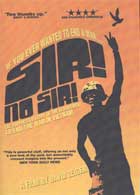
Sir! No Sir! 2005
Distributed by Bullfrog Films, PO Box 149, Oley, PA 19547; 800-543-FROG (3764)
Produced by Displaced Films in association with ARTE/France
Directed by David Zeiger
DVD, color, 84 min.
College - Adult
History, Military Studies, Political Science, Vietnam War
Date Entered: 10/12/2006
ALA Notable: ALA.gif
Reviewed by Rebecca Adler, College of Staten Island, City University of New York
The powerful, profound emotions evoked by Sir! No Sir, a film about the spontaneous to begin with, then organized, resistance on the part of U.S. soldiers to the war in Vietnam remain with you long after the film is over. Those emotions are not all of a piece. There’s the disgust brought on by a brutal war gone terribly wrong, a war that was a bad idea in the first place. The film doesn’t provide much historical context. Viewers will have to go elsewhere to be reminded of the partition between communist North and non-communist South Vietnam, the domino theory justification for the war, the Vietcong guerrillas – a story already well told in the 1974 Peter Davis documentary, Hearts and Minds. Rather Sir! No Sir, subtitled The Suppressed Story of the GI Movement to End the War in Vietnam, focuses on the ground soldier’s view of the war – the view that the perceived enemy enjoyed the support of the local population and that therefore the war was a war against that population, resulting in torture, atrocity, mayhem, all of it futile. (Another Vietnam War documentary, Winter Soldier also focuses on the ground soldier’s view of the war). These day to day realities caused some remarkable individuals of disparate backgrounds – Green Beret David Duncan, dermatologist Dr. Howard Levy, Nurse Susan Schnall, GI David Cline, and others – to refuse to participate. It’s the courage of these individuals – who risked the full force of the military’s retaliatory authority, threatened as they were with interminable prison sentences for defying orders – that the film portrays and celebrates. But refuse and resist they do. And the movement grows. Coffee houses where the word is spread spring up near military bases and are attacked and vandalized. Hundreds of underground newspapers, their staffs subject to courts martial, circulate and further spread the word. Still the movement grows, eventually merging with the massive civilian anti-war movement itself. The army slogan “Fun Travel Adventure” becomes the rallying cry “F the Army!” Celebrities such as Jane Fonda tour among the troops and give more support to the dissenters.
By 1970, military statistics tally over 500,000 “incidents of desertion” in the ranks! In the film talking heads alternate with contemporary documentary footage. The contrast between the unblemished faces of the young men and women way back when and their sometimes weathered, sometimes serene present faces is so deeply affecting that finally, it’s the extraordinary moral and physical courage of the individuals who instinctively and intellectually knew right from wrong that movingly stays with you, and continues to stay.